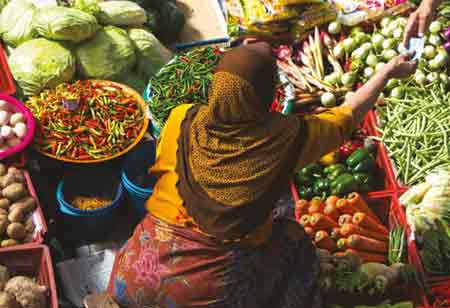Thank you for Subscribing to Food Business Review Weekly Brief
- Home
- Topics
- Alternative Proteins and Plant Based Food
- Beer and Wine
- Canned Beverages
- Coffee And Tea
- Food and Beverage Consulting
- Food and Beverage Financial Service
- Food And Beverages Marketing
- Food Distributors
- Food Ingredients
- Food Sustainability
- Plant Based Food and Beverages
- Seafood Suppliers
- Supplement Manufacturing
- Wine Investment
- News
- Vendor Viewpoint
- CXO Insights
- Conferences
- Newsletter
- CXO Awards
-
Safety First: Transforming Food Practices For A Healthier Future

By
Food Business Review | Wednesday, April 09, 2025
Stay ahead of the industry with exclusive feature stories on the top companies, expert insights and the latest news delivered straight to your inbox. Subscribe today.

Food safety is paramount for public health, assuring that the food consumed by individuals is free from adulterations and contamination that could cause harm. It contains a range of procedures and regulations developed to regulate foodborne infections and retain the nutritional value of food. As populations grow and global supply chains expand, safeguarding the integrity of food systems has become increasingly complex and critical. The threats associated with unsafe food and the measures are necessary to ensure high food production, distribution, and consumption standards.
Food safety instantly impacts human health, economic stability, and social well-being. Contaminated food can harbor harmful bacteria, viruses, parasites, or chemicals that lead to salmonella, listeriosis, and food poisoning. Unsafe food creates economic burdens through medical expenses, lost productivity, and businesses’ financial losses during recalls and lawsuits. Beyond monetary impacts, food safety issues erode consumer trust and compromise social stability by exacerbating access to safe and nutritious food inequalities. Promoting food safety is a health imperative and an ethical responsibility
Food safety risks can arise at any step of the food supply chain, but it is essential to sanitize it to meet the standard requirements. Improper usage of pesticides, contamination from polluted water sources, and inadequate hygiene methods among workers can introduce hazards. Cross-contamination and failure to adhere to temperature management during processing and packaging can compromise food integrity. Improper storage conditions, like exposure to fluctuating temperatures or unsanitary environments, can degrade food quality. At the consumer level, mishandling food during preparation or neglecting to follow storage instructions can lead to contamination and illnesses.
Emerging challenges like antimicrobial resistance (AMR) and climate change threaten food safety. Overusing antibiotics in livestock leads to AMR, causing some foodborne pathogens to be challenging to treat. Climate change affects the majority of foodborne pathogens by changing environmental conditions that favor their growth. Managing food safety risks requires an approach that involves stakeholders across the food system. Adhering to food safety principles minimizes risks and ensures safe food production. Washing hands, utensils, and surfaces prevents contamination from harmful microorganisms.
Keeping food safe is indispensable when it is related to avoiding cross-contamination between raw meats and readyto-eat items. Cooking food at the proper temperatures is key to eliminating harmful germs and helping prevent foodborne illnesses. Storing hot or cold perishable items is vital to slow bacterial growth. Ensuring that water and ingredients are safe is another crucial step in food preparation. Everyone has a role in this effort—governments, international organizations, and businesses all contribute to enforcing food safety standards. Global standards provide guidelines that help align food safety practices worldwide.
Inspections, certifications, and traceability strategies help confirm compliance with these standards. Focusing on preventive measures and holding each part of the food supply chain accountable helps to ensure the safety of what people eat. Together, these efforts make meals safer and healthier for everyone. Latest and advanced technologies like blockchain and IoT devices enable real-time monitoring and tracking of food products, enhancing transparency and accountability. Fostering collaboration among various countries facilitates sharing best practices and resources to address transboundary food safety issues.
Educating everyone involved in food production and handling about effective food safety management offers a crucial advantage. Food producers and handlers need to grasp the risks tied to their operations and know how to address them. By participating in training programs and workshops and obtaining certifications, workers gain valuable knowledge that empowers them to maintain high food safety standards. The educational efforts ensure that the food consumed is safe and healthy. Public awareness campaigns are instrumental in teaching everyone about proper food storage, preparation, and hygiene practices.
Advancements in technology have transformed how we monitor and enforce food safety. For instance, rapid testing methods, such as polymerase chain reaction (PCR) assays, allow for the swift detection of pathogens in food samples, greatly enhancing our ability to keep food safe. Blockchain technology enhances traceability, allowing stakeholders to track a product’s journey from farm to fork. The transparency aids in quickly identifying sources of contamination and the scope of recalls. AI and data analytics improve risk assessment and predictive modeling, allowing foreseeing responses to possible threats.
Stakeholders must concentrate on creating resilient food systems. It needs to integrate sustainability into food safety strategies. Reducing food waste, improving water management, and adopting sustainable farming practices enhance safety while handling environmental concerns. Collaborations between the public and private sectors can foster innovation and attract investments in infrastructure, research, and capacity-building efforts. The efforts between governments, industries, and academic institutions accelerate progress toward a safer and more sustainable food supply.






